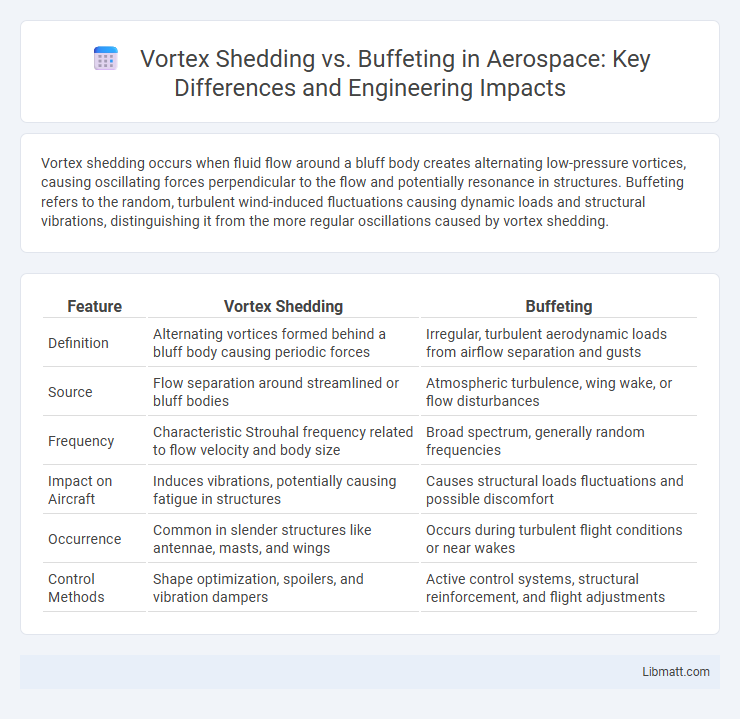Vortex shedding occurs when fluid flow around a bluff body creates alternating low-pressure vortices, causing oscillating forces perpendicular to the flow and potentially resonance in structures. Buffeting refers to the random, turbulent wind-induced fluctuations causing dynamic loads and structural vibrations, distinguishing it from the more regular oscillations caused by vortex shedding.
Table of Comparison
| Feature | Vortex Shedding | Buffeting |
|---|---|---|
| Definition | Alternating vortices formed behind a bluff body causing periodic forces | Irregular, turbulent aerodynamic loads from airflow separation and gusts |
| Source | Flow separation around streamlined or bluff bodies | Atmospheric turbulence, wing wake, or flow disturbances |
| Frequency | Characteristic Strouhal frequency related to flow velocity and body size | Broad spectrum, generally random frequencies |
| Impact on Aircraft | Induces vibrations, potentially causing fatigue in structures | Causes structural loads fluctuations and possible discomfort |
| Occurrence | Common in slender structures like antennae, masts, and wings | Occurs during turbulent flight conditions or near wakes |
| Control Methods | Shape optimization, spoilers, and vibration dampers | Active control systems, structural reinforcement, and flight adjustments |
Introduction to Vortex Shedding and Buffeting
Vortex shedding is a fluid dynamics phenomenon where alternating low-pressure vortices form behind a bluff body, causing periodic forces that can induce structural vibrations. Buffeting refers to the aerodynamic instability caused by turbulent wind flow and vortex shedding impacts, resulting in fluctuating loads on structures such as bridges and tall buildings. Understanding the interaction between vortex shedding frequencies and structural natural frequencies is essential to prevent resonance and ensure structural integrity.
Defining Vortex Shedding
Vortex shedding is a fluid dynamics phenomenon where alternating low-pressure vortices form downstream of a bluff body, causing periodic oscillating forces on structures such as bridges or chimneys. Unlike buffeting, which results from turbulent wind gusts producing irregular loads, vortex shedding generates a consistent frequency of oscillations that can lead to resonance and structural fatigue. Understanding vortex shedding helps you design buildings and towers that mitigate oscillations and maintain structural integrity.
Understanding Buffeting
Buffeting occurs when aerodynamic forces cause continuous, irregular vibrations on a structure, often due to turbulent airflow or abrupt changes in wind speed and direction. Unlike vortex shedding, which produces periodic oscillations at a specific frequency, buffeting results in broadband excitation with varying frequencies that can severely impact structural stability. Understanding buffeting helps you design effective damping and control measures to mitigate these unpredictable wind-induced forces.
Key Differences Between Vortex Shedding and Buffeting
Vortex shedding is a fluid dynamic phenomenon where alternating low-pressure vortices are generated behind a bluff body, causing oscillatory forces perpendicular to the flow direction, typically at a characteristic Strouhal frequency. Buffeting refers to the unsteady aerodynamic loading on structures such as aircraft wings or tall buildings, induced by turbulent flow or wake interactions, resulting in irregular, broadband vibrational responses. Key differences include vortex shedding's periodic and frequency-specific nature versus buffeting's broadband, stochastic excitation, with vortex shedding often producing coherent, vortex-induced vibrations and buffeting causing more complex, multi-directional structural responses.
Mechanisms Behind Vortex Shedding
Vortex shedding occurs when alternating low-pressure vortices form behind a bluff body, causing cyclic forces perpendicular to the flow direction. This phenomenon results from the separation of the boundary layer and the periodic detachment of vortices, creating oscillating wake patterns. You can minimize the impact of vortex shedding by optimizing the shape and structural stiffness to avoid resonance with shedding frequency.
Causes of Buffeting in Structures
Buffeting in structures is caused by turbulent wind flows interacting with the structure's surface, leading to random pressure fluctuations and dynamic loading. Unlike vortex shedding, which results from periodic vortex formation and shedding at specific frequencies, buffeting encompasses a broad range of aerodynamic forces due to upstream turbulence and flow separation. These irregular aerodynamic forces induce vibrations that can affect structural integrity and comfort.
Impacts of Vortex Shedding on Engineering Design
Vortex shedding creates periodic forces that can induce vibrations in structures such as bridges, chimneys, and towers, potentially leading to fatigue and structural failure if not properly accounted for in engineering design. Understanding the frequency and amplitude of vortex-induced oscillations is essential to implement effective damping solutions and ensure the longevity of your structure. Engineers use wind tunnel testing and computational fluid dynamics to predict these impacts accurately and optimize design parameters accordingly.
Effects of Buffeting on Structural Performance
Buffeting induces fluctuating aerodynamic forces on structures, causing random vibrations that can lead to material fatigue and reduced service life. Its irregular, high-amplitude load patterns challenge structural damping systems, increasing the risk of resonance and potential structural damage. Effective design must incorporate robust dynamic analysis to mitigate buffeting's impact on structural integrity and performance under turbulent wind conditions.
Mitigation Techniques for Vortex Shedding and Buffeting
Mitigation techniques for vortex shedding include the use of helical strakes, fairings, and tuned mass dampers to disrupt vortex formation and reduce oscillations on structures such as bridges and chimneys. Buffeting control involves aerodynamic shaping, addition of spoilers, and structural damping to minimize wind-induced fluctuating pressures on tall buildings and towers. Your choice of mitigation depends on the specific frequency and amplitude of excitation, requiring tailored solutions to enhance structural stability and longevity.
Conclusion: Choosing the Right Approach for Structural Stability
Vortex shedding causes periodic forces from fluid flow, leading to oscillations that require detailed aeroelastic analysis for slender structures. Buffeting results from turbulent wind gusts causing random, non-periodic loads demanding robust damping and stiffness considerations. Selecting the right approach depends on the structure's geometry, environmental conditions, and dynamic response goals to ensure optimal structural stability and safety.
vortex shedding vs buffeting Infographic

 libmatt.com
libmatt.com